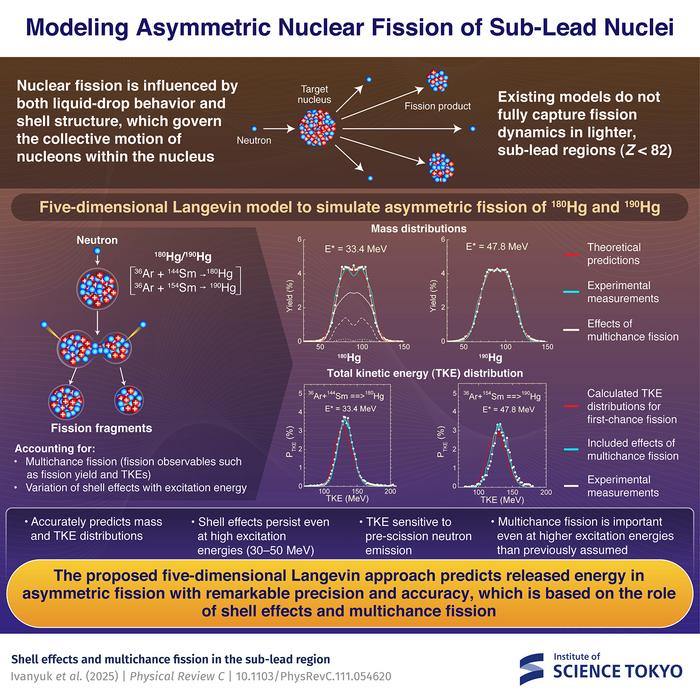
In the ever-evolving landscape of nuclear physics, a groundbreaking computational study has emerged, shedding new light on the complex phenomenon of fission in medium-mass mercury isotopes. This international collaborative effort, spearheaded by Associate Professor Chikako Ishizuka from the Institute of Zero-Carbon Energy at the newly established Institute of Science Tokyo, introduces an innovative five-dimensional Langevin model. Their findings not only reproduce experimental observations with unprecedented precision but also challenge long-standing assumptions concerning nuclear shell effects at elevated excitation energies—a crucial development in understanding the enigmatic sub-lead region of the nuclear chart.
Nuclear fission, the process by which an atomic nucleus splits into smaller fragments, is foundational to both fundamental physics and practical applications such as nuclear energy production. While the fission behavior of heavy elements like uranium and plutonium has been extensively characterized, lighter nuclei such as mercury have exhibited perplexing phenomena that defy conventional models. Notably, mercury-180 (^180Hg) manifests an unusual asymmetric fission pattern, producing fragment distributions markedly different from expectations. These anomalies highlight significant gaps in existing theoretical frameworks and necessitate a reexamination of the underlying nuclear structure influences governing fission pathways.
The key theoretical advancement presented by Ishizuka and colleagues is their development of a five-dimensional dynamical Langevin approach that simulates the nuanced shape evolution of fissile nuclei beyond static approximations. Unlike earlier models constrained to simplified parameters, this comprehensive 5D framework traces the nucleus’s transformation from near-equilibrium configurations through to scission—the point of actual division into daughter fragments. This method integrates both macroscopic liquid-drop dynamics and microscopic shell effects, offering a realistic portrayal of how nuclear shapes and energies evolve in a coupled, stochastic environment.
.adsslot_tZN1QcBdhb{width:728px !important;height:90px !important;}
@media(max-width:1199px){ .adsslot_tZN1QcBdhb{width:468px !important;height:60px !important;}
}
@media(max-width:767px){ .adsslot_tZN1QcBdhb{width:320px !important;height:50px !important;}
}
ADVERTISEMENT
Crucially, the research team applied this sophisticated modeling to two mercury isotopes, ^180Hg and ^190Hg. These isotopes were experimentally synthesized via collision reactions involving argon projectiles (^36Ar) with samarium targets (^144Sm for ^180Hg and ^154Sm for ^190Hg). By simulating the entire dynamical fission process, the team calculated fragment mass distributions alongside total kinetic energies (TKE) of emitted fragments, producing results that align strikingly well with experimental datasets. Notably, the model captures the signature “double-humped” mass distribution characteristic of ^180Hg fission—a feature that had eluded robust theoretical reproduction until now.
An innovation underpinning their success is the implementation of a “soft wall” boundary condition within the deformation space governing nuclear shapes. This technique prevents unphysical behaviors at the edges of allowed deformation parameters, enabling smooth and realistic transitions of nuclear configurations as the nucleus elongates, necks, and ultimately cleaves. Such fidelity in shape evolution is key to replicating the subtle interplay between liquid-drop macroscopic forces and quantum-mechanical shell corrections, especially near scission where fragment properties are effectively “frozen in.”
One of the most striking impacts of this study is its revelation about shell effects in the sub-lead region. Traditionally, it was believed that shell corrections—a quantum effect related to the arrangement of protons and neutrons within nuclear potential wells—attenuate rapidly with rising excitation energy, disappearing beyond approximately 30 MeV of internal energy. Contrary to this, the new simulations demonstrate persistent shell influences on fission dynamics up to energies as high as 40 to 50 MeV, maintaining distinct effects on fragment mass splits and kinetic energies. This persistence necessitates a revision of theoretical assumptions and highlights the robustness of nuclear shell structures under energetic conditions.
Moreover, the model integrates the phenomenon of multichance fission, wherein the pre-fission nucleus emits neutrons in successive stages before final division. This sequential neutron evaporation alters the effective excitation energy and nuclear composition at the time of scission, impacting observables in subtle yet measurable ways. Although multichance fission minimally sways the mass distributions at lower excitations, its effect on the total kinetic energy distributions is pronounced. Hence, TKE measurements emerge as sensitive probes of pre-fission neutron emission processes, enriching experimental interpretive capabilities.
The collaborative nature of this endeavor brings together expertise across multiple institutions: from Dr. F. A. Ivanyuk of the Institute for Nuclear Research in Ukraine to Professor C. Schmitt at the University of Strasbourg in France, and researcher Satoshi Chiba of NAT Co., Ltd. in Japan. This international scope underscores the global drive to refine nuclear reaction models and deepen our understanding of fundamental nuclear processes beyond the actinide region, bridging theoretical predictions with experimental nuclear physics.
In her reflections on the study, Associate Professor Ishizuka emphasized the need to transcend the traditional focus on heavy nuclei like uranium and plutonium. “To fully comprehend fission mechanisms, it is essential that theoretical models reliably capture dynamics across the nuclear landscape, including lighter nuclei such as mercury isotopes that defy classical expectations,” she noted. The 5D Langevin framework developed here provides just such a universal tool, with predictive power validated against empirical data.
The findings carry significant implications not only for nuclear physics theory but also for wider fields such as astrophysics, where fission plays a critical role in nucleosynthesis pathways, as well as practical domains including nuclear energy and reactor design. Understanding the intricate balance of forces and shell structures in fission contributes to better predictions of fragment yields, radiation outputs, and energy release—parameters vital for both safety assessments and technological innovations.
Published on May 20, 2025, in the peer-reviewed journal Physical Review C and distinguished as an Editor’s Suggestion, this research marks a milestone in the quest to unlock the complexities of nuclear fission in the sub-lead region. The integration of advanced computational methods with detailed nuclear physics increases confidence in theoretical tools to describe a broad range of isotopes and nuclear conditions.
Institute of Science Tokyo, established recently through the merger of Tokyo Medical and Dental University and Tokyo Institute of Technology, has positioned itself at the forefront of scientific innovation with this contribution, reinforcing its mission to advance science and human wellbeing. This research exemplifies their commitment to pushing boundaries and expanding knowledge in fundamental and applied sciences.
As experimental techniques continue to refine and new isotopes are explored, this five-dimensional Langevin approach stands as a vital model for interpreting future data and guiding exploratory nuclear science. The revelation of enduring shell effects and the nuanced role of multichance fission open fresh avenues for research, inviting further theoretical and experimental collaboration worldwide.
This study not only deepens our understanding of nuclear fission mechanics but also underscores the importance of integrating multidimensional, dynamic perspectives to capture the true essence of nuclear transformations. It presents a compelling case for revisiting nuclear paradigms and embracing complexity as a pathway to clarity in the microscopic realms of atomic nuclei.
Subject of Research: Not applicable
Article Title: Shell effects and multichance fission in the sub-lead region
News Publication Date: 20-May-2025
Web References: https://doi.org/10.1103/PhysRevC.111.054620
References: Physical Review C, DOI: 10.1103/PhysRevC.111.054620
Image Credits: Institute of Science Tokyo
Keywords
Nuclear physics, Fission reactions, Nuclear reactions, Isotopes, Particle physics, Physical sciences
Tags: advancements in nuclear energy researchasymmetric fission patternscomputational study in nuclear physicsexcitation energies in nuclear physicsfive-dimensional Langevin modelfundamental physics of fissionmedium-mass mercury isotopesmercury-180 fission behaviornuclear fission modelsnuclear shell effectssub-lead region of nuclear charttheoretical frameworks in nuclear structure



